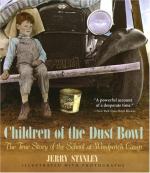
|
| Name: _________________________ | Period: ___________________ |
This test consists of 15 multiple choice questions and 5 short answer questions.
Multiple Choice Questions
1. How did Horace Ray Conley describe the sky during the dust storms?
(a) Black.
(b) Red.
(c) Yellow.
(d) Gray.
2. From 1930 through 1940, the number of dust bowl farmers declined by how many?
(a) 100,000.
(b) 300,000.
(c) 200,000.
(d) 400,000.
3. What city was the Dust Bowl centered near?
(a) Goodwell, OK.
(b) Beaver, OK.
(c) Tuscon, OK.
(d) Hooker, OK.
4. Where were Okies allowed to sit in movie theaters during their discrimination in California?
(a) The front row.
(b) The basement.
(c) The balcony.
(d) The back row.
5. What is the County Seat of Cimarron County?
(a) Tulsa.
(b) Prairieville.
(c) Boise City.
(d) Oklahoma City.
6. Where did Rosalene Long's family get caught in a flood as they headed west?
(a) Phoenix, Arizona.
(b) Santa Fe, New Mexico.
(c) Gallup, New Mexico.
(d) Los Angeles, California.
7. The Tehachapi Mountains lead directly into what valley in California?
(a) Antelope Valley.
(b) Sacramento Valley.
(c) Death Valley.
(d) San Joaquin Valley.
8. How old was Rosalene Long when her family left Stuart, Oklahoma?
(a) Three.
(b) Nine.
(c) Twelve.
(d) Six.
9. Where was Horace Ray Conley from?
(a) Foss, OK.
(b) Prairieville, OK.
(c) Oklahoma City, OK.
(d) Tulsa, OK.
10. What word to the Okies represented a magical place with better lives?
(a) California.
(b) New York.
(c) Canada.
(d) Oregon.
11. What was the first Texas town recalled by the Okies on their trek west?
(a) Longhorn.
(b) Amarillo.
(c) Shamrock.
(d) Dallas.
12. Where did the roads begin climbing into the Black Mountains as the Okies traveled west?
(a) Whitney, California.
(b) Kingman, Arizona.
(c) Anderson, Arizona.
(d) Santa Fe, New Mexico.
13. The excess of farm workers arriving in California in the 1930s was good for the farmers because it did what?
(a) Drove prices up.
(b) Drove wages down.
(c) Drove wages up.
(d) Drove prices down.
14. What would people sleep with on their faces to protect themselves from the dust?
(a) Face masks.
(b) Blankets.
(c) Pillow cases.
(d) Wet rags.
15. Where was the man from who claimed in Chapter Two: Mother Road, "All you could hear was 'Going to Californ-I-A!'"?
(a) Porum, OK.
(b) Camden, OK.
(c) Prairieville, OK.
(d) Oklahoma City, OK.
Short Answer Questions
1. Where was help supposedly needed on cotton and vegetable farms in California after the arrival of the Okies?
2. What did the headlines scream in California in Chapter Four?
3. In what year did the winds of the Dust Bowl finally subside?
4. What term refers to the sharp, nasal tone of the Okie dialect?
5. What happened to many of the Okies who defended their honor against prejudice?
|
This section contains 406 words (approx. 2 pages at 300 words per page) |

|




